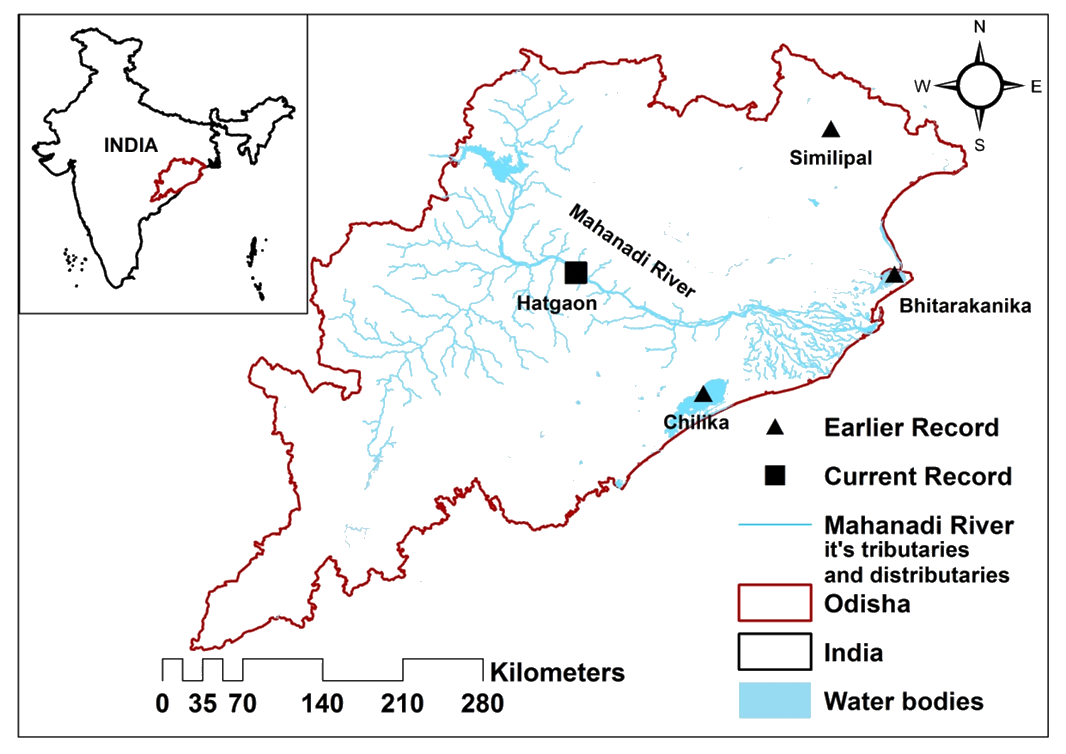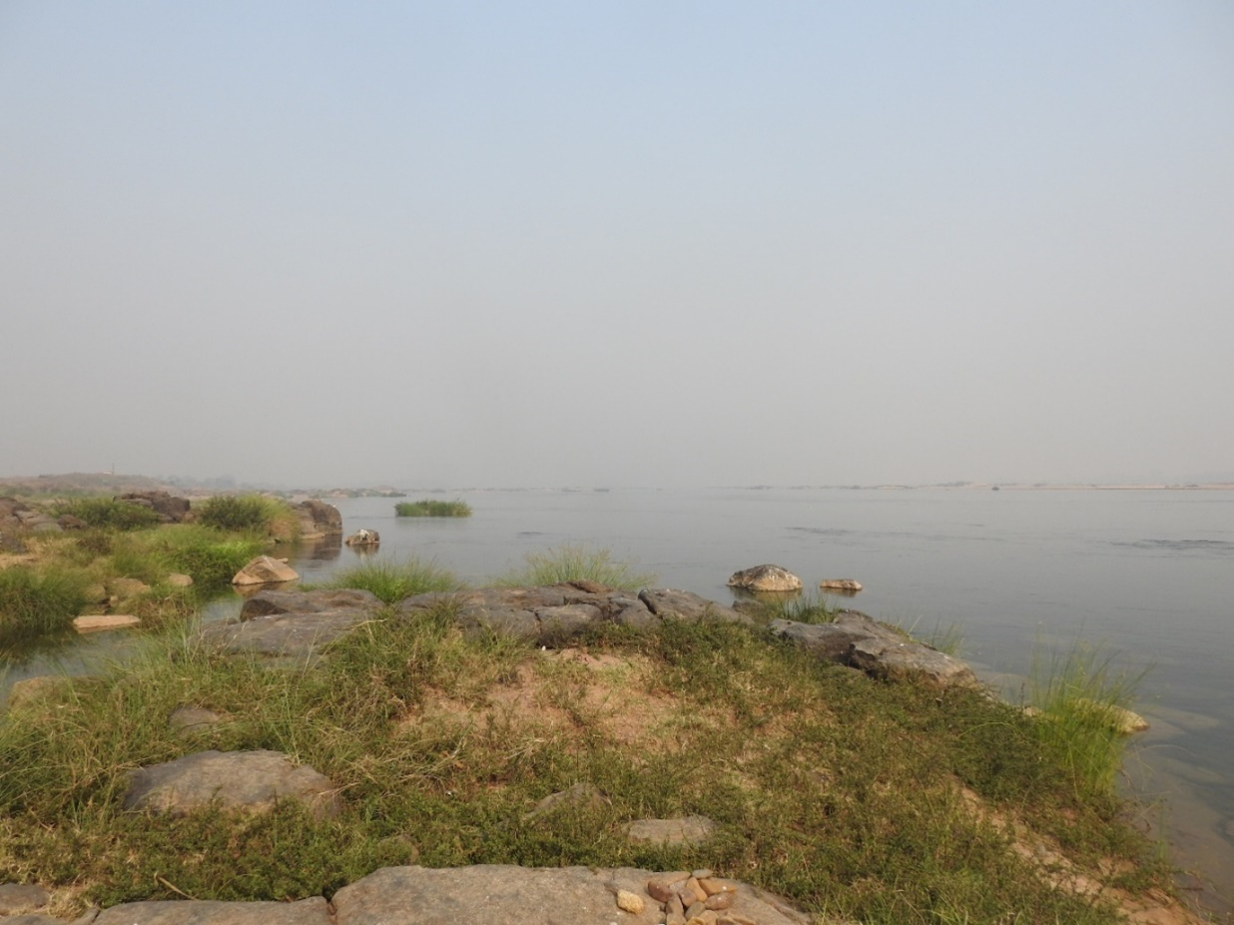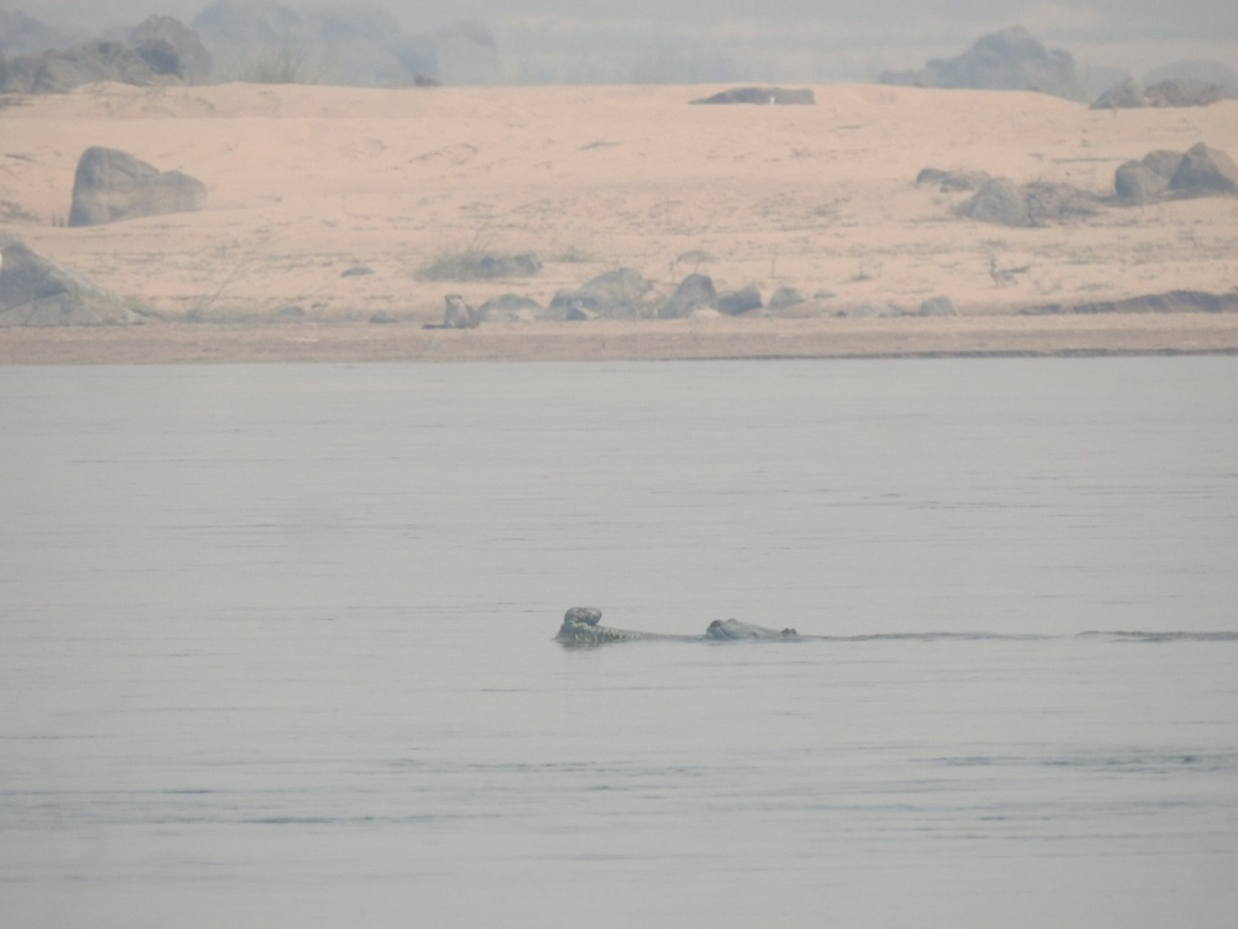IUCN/SSC Otter Specialist Group Bulletin

©IUCN/SCC Otter Specialist Group
Volume 40 Issue 2 (April 2023)
Citation: Rath, L.P., Ashaharraza, K. and Dash, S.K. (2023). A Rare Sighting of Smooth-Coated Otter (Lutrogale perspicillata) in the Mahanadi River, Odisha, India. IUCN Otter Spec. Group Bull. 40 (2): 90 - 95
A Rare Sighting of Smooth-Coated Otter (Lutrogale perspicillata) in the Mahanadi River, Odisha, India.
Laxmi Prasad Rath1, Khan Ashaharraza2, and Suraj Kumar Dash3*
1School of Life Sciences, Sambalpur University, Jyoti Vihar, Burla, India-768019
2Department of Environmental Science, Siksha-O-Anusandhan Deemed to be University, Bhubaneswar, India- 751030
3Wildlife Institute of India, Dehradun, India- 248001
*Corresponding Author Email: surajkumardash5584@gmail.com
Received 8th December 2022, accepted 19th January 2023
Abstract: The smooth-coated otter (Lutrogale perspicillata) is an apex predator and indicator species in the aquatic ecosystem. Herein, we report a rare sighting of this species based on photographic evidence from the Mahanadi River in the central part of Odisha state. Our report of this highly threatened species from the central part of the state has ecological significance and will aid in their conservation and management planning. We urge further surveys to obtain detailed information on their population status in the human-dominated area of this river basin. Historical context, traditional ecological knowledge and the research gap have been discussed.
Keywords: Lutrogale perspicillata, Indigenous knowledge, photographic evidence, threats
INTRODUCTION
The Smooth-coated otter Lutrogale perspicillata (Geoffroy, 1826) is an elusive amphibious mammal distributed throughout the Oriental region (Hussain, 1993). It is a social species and prefers the wetland ecosystem, such as large rivers, lakes, swampy areas, mangroves, coastal areas etc. In recent few decades, due to several human introduced threats such as habitat loss, degradation, poaching, illegal trading, pollution and eutrophication of the aquatic bodies, etc., there has been a decline of >30% of their population (Khoo et al., 2021). As a result, the species have been enlisted in the “Vulnerable” category in the IUCN Red List of Threatened species. There are three species of otters, i.e., Smooth-coated otter (Lutrogale perspicillata), Eurasian otter (Lutra lutra) and Asian small-clawed otter (Aonyx cinereus) which are found in India, have already been reported in Odisha state (Palei et al., 2022; Palei et al., 2020; Adhya and Dey, 2020; Mohapatra et al., 2014). However, earlier reports of smooth-coated otters are primarily from the coastal zones of the Odisha state and the distributaries of this Mahanadi River (Acharjyo, 1999; Mishra et al., 2018; Palei et al., 2020; Adhya, 2020). Hence, our report from the hinterland of the state carries significant importance from the conservation perspective of this highly threatened species.
OBSERVATIONS
On dated 28th March 2022, during a field survey of the upstream areas in the Mahanadi River, two otters were sighted and photographed by a digital camera Nikon Coolpix P900™ (Fig. 3,4) at Hatagaon, Boudh (20.74870°N, 84.38819°E) (Fig. 1,2). The animals were identified as smooth-coated otters considering the reference guide of Menon (2017). The individuals were observed resting over the sandbank on the shoreline in the early hours of the day and were seen grooming, playing, and swimming for the next few minutes. The locality of Hatagaon is 40 km radial ca. upstream from the protected area of Satkosia Gorge Wildlife Sanctuary and nearly 150 km from the Chilika lagoon, the nearest published locality for the species. The river width at the present sighting place is 1400m, out of which 350m of the meandering water channel is on the right bank of the river, and the rest is covered by a large sandbank and stone outcrops at the left bank. The water depth in the river course at the time of observation was around 3-4 meters. Many stone outcrops, vegetation, and sand bars are scattered inside the river channel, and the riverbanks have vegetation with large to small rocks, reiterating the apposite habitat characteristics of otters. The periphery of Hatagaon inhabits more than sixty families of fishermen community who used to catch fish from this river on daily basis. We interviewed the local fishermen community, which stated that the otter species, vernacularly (in Odia language) called Paani-Sena were abundant at the respective locality and often seen in large groups (n=15-20) during the earlier days (dating >50 years back) but now scarce to sight. A few aged fishermen also stated that these animals were killed in large numbers by their forefathers since it was a menace in capture fishing, and young/ orphan otters were often kept as a pet. Around 70% of the respondents who were interviewed and confirmed sightings of otters around Hatagaonarea were more than sixty years of age.




The Gharials (Gavialis gangeticus) and Gangetic softshell turtles (Nilssonia gangetica) have also been sighted in this area, indicating the potential of microhabitat, supporting such highly threatened species. However, illegal activities such as the blasting of dynamites and stone and sand quarries question the long-term survival of these highly threatened species in this region. Being an indicator species to their ecosystem and considering their vulnerability, this species should be provided with legal protection in their habitats. Smooth-coated otters (Lutrogale perspicillata) have an ethnozoological value among the locals around Mahanadi but were never reported scientifically.
CONCLUSION
Despite the fact that Acharjyo (1999) roughly pointed out the presence of otters in the downstream distributaries of Mahanadi in the earlier era, no specific locality or range of distribution for the species was marked. Therefore, the present study serves the first evident record from the main river channel of the Mahanadi and the fourth from the Odisha state. It is also a subsequent range extension of L. perspicillata from Bhitarkanika National Park, Chilika Lagoons and Similipal Tiger Reserve, located around 250km, 150 km and 200 km, respectively: the only other three known localities in Odisha state. Further surveys have been suggested to obtain detailed information on the population status of otters in the Mahanadi River. We also recommend that the authorityprotect this species in this area by taking measures to gain control over the threat of blasting and illegal sand quarrying. In addition, frequent awareness camps should be organized to promote the ecological importance of threatened species, viz. turtles, otters and gharials, among the local people, which we believe must be effective to ensure their smooth existence in their respective habitats.
Acknowledgements: This opportunistic sighting record was a possible outcome of surveys done for Species recovery program for Gharials in Mahanadiriver, Odisha; initiated by Nandankanan Zoological Park funded under CAMPA project. Therefore we thank Director, Deuputy Director and Biologist Nandankanan Zoological Park. We acknowledge DFO, Satkosia and DFO, Mahanadi for logistic support. We thank Gobinda Chandra Mahakud (Gharial Guard, Mahanadi WL Division, Nayagarh) for helping in the surveys. We are thankful to Anisha Afroz (Department of Zoology, Maharaja Sriram Chandra Bhanja Deo University, Baripada) for literature help and Swarup Fullonton (Wildlife Biologist, Kapilash Zoo, Dhenkanal) for species verification.
REFERENCES
Acharjyo, L.N. (1999). Status of Mustelids, Viverrids and Herpestids of Orissa. In: Hussain, S.A. (Ed) Envis Bulletin on Wildlife and Protected Areas. WII, Dehradun, 2: 62–64.
Adhya, T. (2020). Three flagship marshland species found in Odisha’s Chilika lake. https://www.downtoearth.org.in/blog/wildlife-biodiversity/three-flagship-marshland-species-found-in-odisha-s-chilika-lake-69760 . Retrieved on 25th May, 2023.
Adhya, T., Dey, P. (2020). First record of Eurasian otter (Lutra lutra) from Chilika lagoon: a Ramsar site situated on the east coast of India. OTTER, Journal of the International Otter Survival Fund, 6: 49–55.
Hussain, S.A. (1993). Aspects of the ecology of smooth-coated otters Lutra perspicillata in National Chambal Sanctuary. Unpublished PhD Thesis. Centre for Wildlife and Ornithology. Aligarh Muslim University. Aligarh, India.
Khoo, M., Basak, S., Sivasothi, N., de Silva, P.K., Reza Lubis, I. (2021). Lutrogale perspicillata. The IUCN Red List of Threatened Species e.T12427A164579961. https://dx.doi.org/10.2305/IUCN.UK.2021-3.RLTS.T12427A164579961.en Downloaded on 25th May, 2023.
Menon, V. (2017). Secrets lives of Indian Mammals, Hatchett book publishing India pvt. Ltd. 1-256.
Mishra, S.R., Mohan, M., Pati, J.D. (2018). First photographic documentation and distribution of the Smooth-Coated Otter Lutrogale perspicillata in Similipal Tiger Reserve, Odisha, India. IUCN Otter Spec. Group Bull. 35(4): 186–192. https://www.iucnosgbull.org/Volume35/Mishra_et_al_2018.html
Mohapatra, P.P., Palei, H.S., Hussain, S.A. (2014). Occurrence of Asian Small-Clawed Otter Aonyx cinereus (Illiger, 1815) in Eastern India. Current Science, 107(3):367–370.
Palei, N.C., Rath, B.P., Palei, H.S., Acharya, B.P. (2020). Population status and activity pattern of Smooth-Coated Otter (Lutrogale perspicillata) in Bhitarkanika National Park, Odisha, Eastern India. IUCN Otter Spec. Group Bull. 37(4): 205–211. https://www.iucnosgbull.org/Volume37/Palei_et_al_2020.html
Palei, N.C., Palei, H.S., Rath, S., Rath, B.P., Mishra, A.K. (2022). Photographic Record of Eurasian otter Lutra lutra (Linnaeus, 1758) in Odisha, India. IUCN Otter Spec. Group Bull. 39 (2): 102–109. https://www.iucnosgbull.org/Volume39/Palei_et_al_2022.html
Résumé: Une Observation Rare de la Loutre à Pelage Lisse (Lutrogale perspicillata) le long de la Rivière Mahanadi, dans l’ État d’Odisha, en Inde
La loutre à pelage lisse (Lutrogale perspicillata) est un prédateur au sommet de la pyramide alimentaire et une espèce indicatrice de l’écosystème aquatique. Nous mentionnons dans cette étude une observation rare de cette espèce basée sur des preuves photographiques de la rivière Mahānadī dans la partie centrale de l’état d’Odisha. Notre rapport consacré à cette espèce hautement menacée de la partie centrale de l’État a une importance écologique et contribuera à sa conservation et à la planification de sa gestion. Nous demandons instamment d’autres suivis afin d’obtenir des informations détaillées sur le statut de la population de ce bassin fluvial situé dans une zone fortement occupée par l’homme.
Revenez au dessus
Resumen: Un Raro Avistamiento de Nutria Lisa (Lutrogale perspicillata) en el Río Mahanadi, Odisha, India
La nutria lisa (Lutrogale perspicillata) es un predador tope y especie indicadora en los ecosistemas acuáticos. Aquí, informamos de un raro avistamiento de ésta especie, en base a evidencia fotográfica del río Mahanadi, en la parte central del estado de Odisha. Nuestro registro de ésta especie altamente amenazada en la parte central del estado tiene significación ecológica, y va a ayudar en su conservación y la planificación de su manejo. Exhortamos a que se realicen más relevamientos para obtener información detallada sobre su status poblacional en el área dominada por humanos de ésta cuenca fluvial.
Vuelva a la tapa


